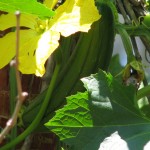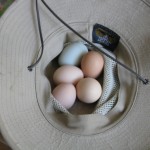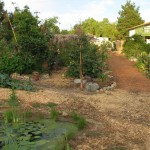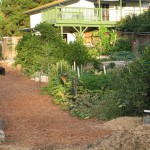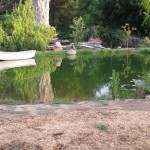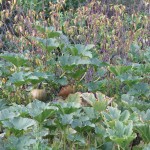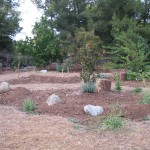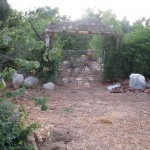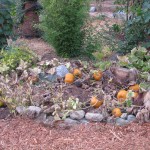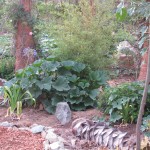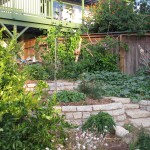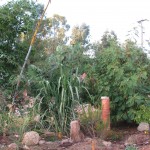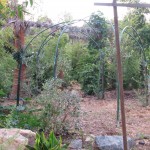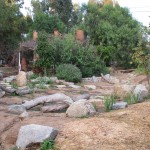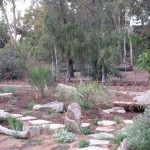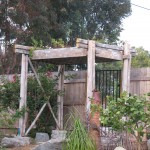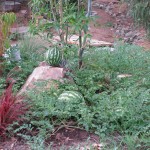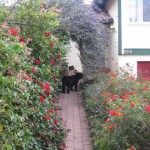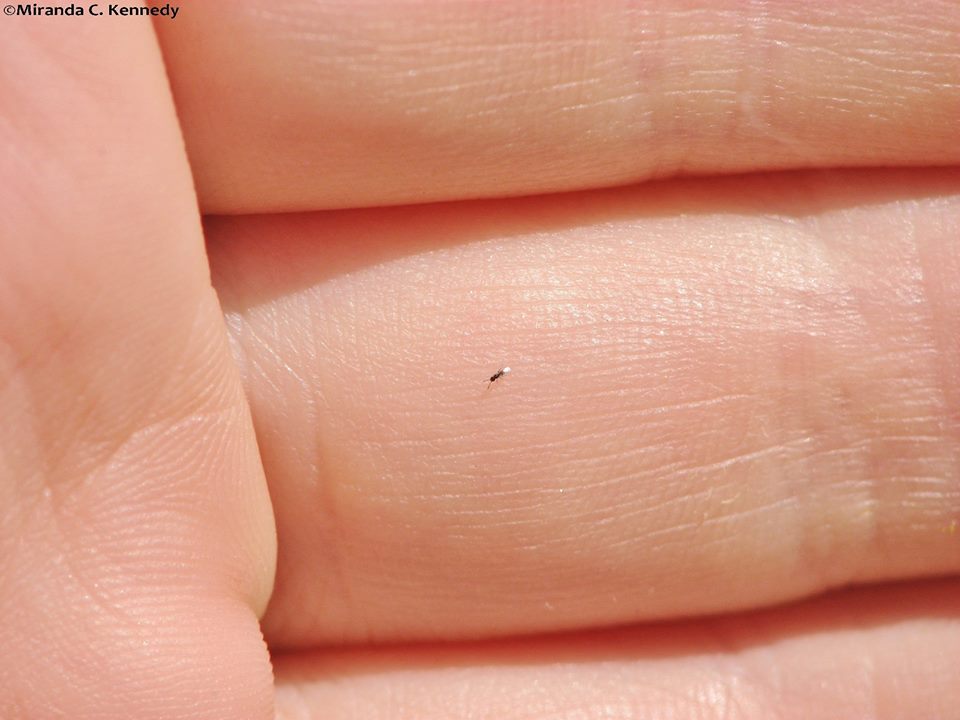Animals
- Chickens, Gardening adventures, Heirloom Plants, Permaculture and Edible Forest Gardening Adventures, Photos, Ponds, Rain Catching, Vegetables, Vegetarian
The August Garden
Plants have been enjoying the beautiful weather and the constant irrigation from the well, and the garden is flourishing. So, unfortunately, is the Bermuda grass, but that is another tale. Since I see it everyday I don’t notice the change so much, but when I show someone around I am thrilled all over again with the incredible change that has happened on this property. There are so many birds, insects, reptiles and other animals either already here or scouting it out that I know the project is a success. It is a habitat, not just for me and my family, but for native flora and fauna as well. It wasn’t so long ago that I had a cracked, weedy asphalt driveway, a termite-ridden rickety porch that needed pest control, a house with a stinky deteriorating carpet and old splotchy paint, a tile kitchen counter with the grout gone in between and a cleaning nightmare, and a yard full of snails, weeds and Washingtonia palm trees, with the embankment eroding each rainfall. Over the last four years we’ve survived some pretty intense construction projects (none of which were done on time, no matter what they promised!). My house still has some repairs that need to be done but I no longer am embarrassed to have anyone over. The garden is wonderful to walk in and explore. I’ve taken some photos this evening to show you how things are growing:
Bees enjoying purple coneflowers The luffa squash has mighty asperations. A luffa squash and bloom. They are edible small and green, but I’ll leave them to dry. Five eggs today! Each laying hen participated for the first time! The little girls have grown up. The small lower pond and the palm pathway. The veggie bed. Rushes, fleabane, waterlilies and other plants are growing in nicely around the big pond. The boat is still on loan from Aquascape. A pumpkin tree? This apricot isn’t healthy, but the pumpkins sure are. These bare areas I’ll fill with plants that will make up guilds, each plant filling a niche to help the others grow. The entrance to the bee garden. Native vinegar weed loves a place we left untouched, and so do the bees. Sugar pumpkins ready a little early for Halloween. A feral zucchini, still producing at least one a day. Melons, passionfruit, pitcher plant and many others under the back porch we call the Poop Deck. Very eager bamboo, sugarcane and hops. Olive trees tied to painted PVC pipe to make a hut. The ‘Nest’ beyond the dry stream bed. A thud and a swish… with no warning the neighbor’s tree fell across the fence. A green roof for the entranceway, just beginning to show. The watermelons in the vegetable beds were tiny… these monsters are wild. That one grew on the rock on its own. Entranceway flower tunnel… with dogs waiting to go inside! -
Dedicated to Evelyn

Almost time.... We’ve gathered seven eggs from the girls this week. We believe the first one was Evelyn’s, the beautiful blond Buff Orpington. The next ones are Miss Amelia’s, followed by a blue/green one from Chickpea and unbelievably, a brownish one from our other Americauna, Kakapo.

First three beautiful eggs, L-R Evelyn's, Miss Amelia's and Chickpea's The two Barred Rocks are too young yet to lay, but they certainly are interested in what is suddenly so popular about the nesting boxes.

The Barred Rocks are curious teenagers The nesting platform in the chicken tractor isn’t deep enough to keep straw from being kicked off, so I’ve put up three bee ‘supers’, which are four sides and no top or bottom. Until something else can be arranged, they do just fine.

Miss Amelia, tail up and ready to get it over Watching the girls as they become hens has been interesting. Miss Amelia sat in the nesting box and panted.

As a mom, I know how she's feeling. She allows me to pet her now, as she squats into the mating pose. It is a little disturbing, and doubtlessly frustrating for both her and Emerson who is caged separately.

Miss Amelia is desperate for... attention. Sorry! Chickpea, the big girl, jumps from box to box annoying everyone trying to nest in there. She kicks as much bedding out as she can, sending it flying across the coop with her big feet. When she’s ready to lay she goes into a chicken trance. You can wave your hand in front of her eyes and there is no response, just some panting. Then, voila! A beautiful greenish egg.

Chickpea in a trance Kakapo is the nest builder. She’ll squat down in one of the boxes then lean her head far out of it, almost losing her balance, to grab a wisp of straw to throw over her shoulder into the box.
We hadn’t seen Evelyn lay, but assumed the first egg which was pointier than Miss Amelia’s, was hers. She’d been in a mood for several days and had settled down. Yesterday, though, she sat down in the corner of the pen by her beau Emerson and took a nap in the daytime which was uncharacteristic. She appeared perfectly healthy; in fact, I commented on how red and full her wattles were. This morning we found our dear Evelyn dead on the floor in the corner of the coop. We also found two eggs with transparent shells in the lay box. There was no evidence of what made her die, but I’m guessing it had something to do with the egg-laying. We don’t know who laid the shell-less eggs, but that shouldn’t kill anyone. It is remedied with more calcium in their diets on top of their lay pellets. Perhaps she was egg-bound, or just couldn’t handle the eggs. We were horrified and greatly saddened. I buried Evelyn under the lime tree just behind the coop. Now we have five hens and a rooster. We gave the girls crushed egg shells and kale leaves, and I’ll sprinkle calcium on their food tomorrow. We’ll miss the beautiful Evelyn something terrible.

Evelyn looking great. No signs of illness. -
Stinkhorn!

What is that? There was a surprise in our garden this afternoon. We were weeding and planting a flower seed mixture around the back of the house, and suddenly my daughter excitedly shouted, “Stinkhorn!” I didn’t take offence. I was excited, too. What she was referring to was a reddish, odd-looking fungus that had emerged from the ground next to a rose bush. This fungus makes a rather unpleasant odor, which attracts flies who then carry off the spores. A pretty tricky plant. We had our first and only stinkhorn emerge last year in a different part of our yard, and I was afraid that with all the walking and weeding done in that area, that it wouldn’t be back. Silly me. The fungus was traveling!

Flies enjoying the stink and spreading the spores Then shortly after this discovery and only a few feet from it, I was digging up weeds and found what I thought was a reptile egg. We thought that maybe it was an egg from Mrs. Sabatini, the Western pond turtle that we found on our property and released into our upper pond, never to be seen again. Or perhaps a snake egg.
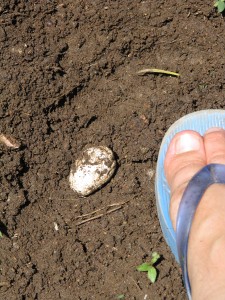
Not a reptile egg When I felt it, however, it was firm and had a little give to it, like it was made of soft rubber. My daughter figured it out. She had read where the stinkhorn spores grow into an egg-shaped, um, thingy, which breaks open underground revealing the slimy gooey part which then pushes up through the ground and begins stinking. The slimy part has the spores on it.

The shiny green interior will thrust out of the ground Fungus is incredible and wonderful. The threads of fungus hold together the soil, feed us, medicate us and yet we know so little about them. An incredible book to read is Mycelium Running: how mushrooms can help save the world, by Paul Stamets. Although most people wouldn’t welcome a stinkhorn into their perennial border, we think it is very cool, as long as there aren’t too many of them!
-
A Little Brown Gift (and it isn’t what you might imagine)
Yesterday’s blog post was my 100th posting. I was wondering what kind of post I should write to celebrate, when my animal family took the decision right out of my hands… and put something else back into my daughter’s hands that was cause for celebration:

Egg! I had just been reminding the girls (hens) that their egg-laying should commence in August, and since they didn’t have a calendar in their coop, what the date was. This afternoon I stepped into their coop to fill their food dispenser, and saw the first egg! So small and so perfect. We aren’t sure whose egg it is, except that it doesn’t belong to Chickpea or Kakapo the Americaunas because they will lay blue and green eggs. Our bet is on Evelyn because she was squawking a lot this week, and since she’s at the top of the pecking order, perhaps she felt that it was her duty to lay first and impress her beau Emerson. Emerson is separated from the girls by chicken wire so that he may keep company, albeit frustrated company, with them. We separated him just in time to not have fertile eggs!

Kakapo wondering how to eat it So the egg is in the refrigerator, the nesting area is replete with straw, and we are eagerly awaiting more eggs. Miss Amelia was showing signs of being disturbed about something. Passing the first egg would be quite uncomfortable, I’m sure. As a mother of two, I’m actually positive about that. Chickpea – who reminds me a bit of Meryl Streep playing Julia Child – was determined to kick all the straw off and bother her, so maybe tomorrow. What a great little brown gift!

Kakapo and Miss Amelia looking at egg - Gardening adventures, Other Insects, Permaculture and Edible Forest Gardening Adventures, Rain Catching, Vegan, Vegetables
Beginning an Edible Forest Garden

Pumpkins by the chickens An edible forest garden is a mode of growing that mimicks the relationships between plants in a forest, while substituting food producing plants for humans. To achieve this, you have to examine what plants grow in forests near you. Here in San Diego County, we have chapparal communities, along with some pine and oak forests in the mountains. I cannot replicate a forest such as found in, say, Olympia, because we have completely different climates, soils, and plant interrelationships. Even for people who live in deserts, you can examine what once was there before the area was a desert, or what plants are in a nearby oasis if you have one. I’d substitute plants for more desirable ones, such as lemonade berry for its cousin poison oak. Plants should provide canopy, groundcover, mulch, nitrogen-fixing, and insect attracting. After these plant guilds mature they will provide fertilizer and moisture for themselves.
However, most of us are far away from this type of gardening, or just don’t want to go that far. Integrating your ornamentals with food plants, though, is not radical anymore and entirely practical. Any nook in your yard can be a place for food producing plants. Too many squash or tomatoes? Take them to a local food pantry.

Melons by a dead lime tree trellis 
A single Cinderella pumpkin vine under an apricot 
Zucchinis make lush bushes 
Watermelons suppressing weeds Tomatoes are a vining plant which will use any upright structure on which to climb.

Can you see the tomato plant? (Its up the palm trunk) Is your produce sprouting in the house? Try planting it instead of composting. Onions make particularly pretty plants with flowers that attract pollinators and hummingbirds. You may collect the seed from them as well. If the produce doesn’t survive, its okay: you’ve just buried compost.

Plant sprouting produce for ornamentals and to gather seed Sweet potatoes are perennial plants that produce swollen rhyzomes rather than swollen roots as other potatoes do. Plant them where you can dig up some of the roots but leave the main plant to thrive for years, depending on your climate. Their leaves are beautiful, and the plants are often sold as ornamentals.

Sweet potatoes have beautiful leaves Herbs in the shrubs, strawberries in the flowers, and melon and squash under the trees all make for a beautiful edible landscape that will provide food, compost, mulch and habitat while you study up for your edible forest garden.

Strawberries with yarrow 
Apple mint attracts pollinators and is good on fruit 
Passionvines are a host plant for Gulf Fritillary butterflies 
Hops are vigorous, tall vines for brewing and sleep pillows 
Grapes will hide a chain link fence -
Hiking Santa Ysabel Open Space Preserve

Ancient god face in wood Today my daughter and my hiking buddy Alex spent almost five hours hiking a seven-mile trail in the stunning Santa Ysabel Preserve. Alex and I hiked the Kanaka Loop trail before, taking less time, but today we stopped often for photographs of the abundant birds, insects, plants and incredible views.

A small pine in the shadow of a fallen giant Managed by the County of San Diego Parks Dept., this open space preserve has two entrances. The West Loop Trail, which is short and mostly easy, is off of Highway 79, and the main entrance and staging area is off of Farmer Road past Julian (http://www.sdcounty.ca.gov/parks/openspace/Santa_Ysabel.html ) . Each entrance offers loop trails, and are connected by a portion of the Coast to Crest Trail.
This preserve is the home of ancient oak riparian woodlands,

Out of a storybook 200-year-old sycamore groves,
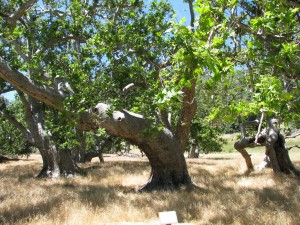
Two-hundred year-old sycamores stunning views of the mountains and hills west, with a glimpse of Palomar Observatory in the far distance

The View towards Palomar Observatory and equally serene pastoral landscapes of mountain homes, apple orchards and rolling hills in the southeast.
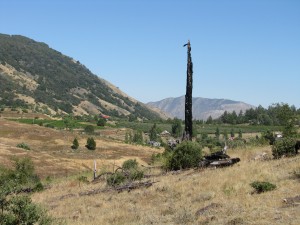
A beautiful valley of apple groves At this time of year the grasslands are pale gold, and ripples travel for acres in the very welcome warm breeze that kept this July day from being overwhelmingly hot.
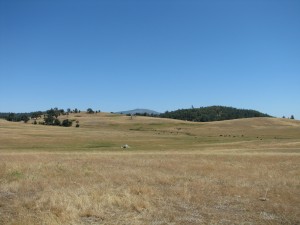
Rolling grasslands A new experience for us was to walk miles of trail while disturbing thousands of grasshoppers that flung themselves out of the way or took wing to avoid us. It was like setting popcorn off as we walked, trying to not tread on any but also being hit by some misdirected fellows. One took a ride on my pants for awhile until he began to investigate my pants pocket and I had to give him a boost to freedom.
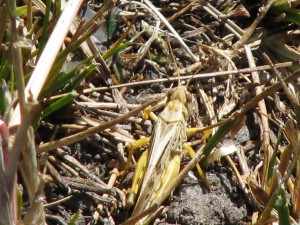
Grasshoppers It was a glorious day for birding; some of the birds we saw were flocks of Western bluebirds, kingbirds, a lark sparrow, a Lazuli bunting, ravens, chipping sparrows, goldfinches, bushtits, both spotted and California towhees, acorn and Nuttall’s woodpeckers, a Northern flicker, a Cooper’s hawk, an American kestrel, Western meadowlarks, brown-headed cowbirds, cliff swallows, Steller and scrub jays, Mountain chickadees, and many turkey families, their brood half-grown and comically awkward. We saw bright red Large Milkweed Beetles on blooming Indian milkweed, a late blooming Summer lupine, and did I mention grasshoppers? Thousands of grasshoppers. Almost the entire hike. A pair of ravens sat in the tall grass to the side of the trail with their beaks open, catching them as they leaped, as did Western bluebirds and others.
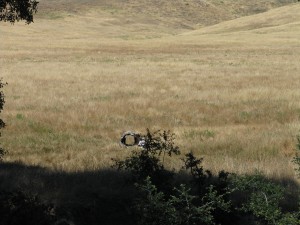
A hollow stump that looks like a TV set The Preserve is also home to cattle, and groups of the little ladies and their offspring dotted the landscape. Many bad cow jokes ensued (they’re in a bad MOOd; you can’t HIDE from them, they are UTTERLY charming, we’ve got to HOOF it past them, let’s MOOve it along… well, you get the picture), and although they watched us warily, they gave us no problem and we spoke to them soothingly as we passed by.
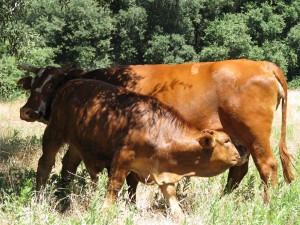
Lunch The Kanaka Loop Trail is easy up to the streambed crossing,

Good run-off for July then it goes uphill in areas which are bare due to elevation and past fires, so there is little cover. Many pines have sprouted up and their fragrance in the heat is intoxicating. However twice during the trail up through the trees we smelled greasy french-fries, and have no idea what plant or combination of flowers created that scent. It is an exceptionally beautiful trail and not difficult for the average hiker, but be sure to take a hat and lots of water, and a good attitude towards cows!
-
The Importance of Leaving a Mess

Animal tunnels through a brush pile A clean yard is usually a pleasing sight. Picking up loose boards, plywood, sticks and logs keeps people from tripping, is encouraged by the fire department to reduce fuel for fires, and makes for more room to walk. Also, things live under debris and we’ve always been told to not poke our fingers into dark places (excellent advice! If a giant stuck his huge finger into our bedroom window we’d try to hurt it to make it go away, too!), and by eliminating so-called debris we reduce the chance of bites by snakes, spiders, or whatever bitey things may be living in your part of the world.
However, by reducing the debris, we also reduce habitat. Those bitey creatures need a place to live, as do the non-bitey creatures we are also displacing by removing wood. All these creatures are part of the intensely woven food web that keeps our planet populated and working. I cannot disagree about making your yard safe for children and pets, but if you have a space, make an area for habitat, too. Rope off a corner of your yard and tell your children and pets not to go into there, and leave bundles of sticks, pieces of plywood, old logs, piles of leaves, etc. in that corner. This is a home for the wild things, and your children can understand, observe and respect the fact that the world should not be made clean for them. Teach your children not to hunt and catch wild things, not to tear apart nests and destroy habitat. Observe and wonder instead.
In my yard, especially since I’ve had some sheds removed (in which racoons, wasps and possums raised families… I’m hoping to make a new place for them), I have stacks of plywood and old buidling materials which are good for recycling back into projects around my house. A junkheap, yes; a goldmine, yep. Under these stacks I have found such wonderful creatures that I didn’t even know came into my yard (perhaps they didn’t until the wood was left out).
The most exciting creature was a female Western pond turtle.

Female Western Pond Turtle In Washington, the Western pond turtles are endangered, and they are considered threatened in Oregon and are becoming rare in California and Baja California. Besides loss of habitat and an increase in pollution, one of the major factors in our native turtle’s slow demise is the release of non-native aggressive species such as the red-eared slider turtles. Red-eared sliders are America’s favorite pet turtle although they are native to the Southern United States. Due to releases they are everywhere. DO NOT RELEASE YOUR PET INTO THE WILD! As much harm has been done by and to domestic animals and wild animals by the releasing of pets as by habitat loss. A number of years ago there was a salmonella scare allegedly traced to pet turtles. The public’s response was to dump their children’s turtles in any waterway close by. Red-eared sliders have a distinctive red line by their eyes, and are named sliders because that family of semi-aquatic turtle can slide into the water quickly. They are omnivorous, aggressive, adaptable and become large. They eat anything that they can fit into their mouths, including the less aggressive smaller Western pond turtles.

Females have flat plasterons; notice her left stumpy leg. Finding a female Western pond turtle in the yard was fantastic, and I can only surmise that she had made her way up from the shallow streambed below the property to hopefully lay eggs. I haven’t found signs of a disturbed area yet where she may have layed, but am keeping the whole area protected just in case.

Long tails She is missing one front foot, probably bitten off while a youngster when something was trying to eat her. Before we knew she was a she, we thought of giving him a piratey name due to the missing foot and her semi-aquatic nature. Captain Blood was too fierce, but the author of that and other swashbuckling tales which had been made into movies is Raphael Sabatini. Now that is a terrific name. Go ahead and say it to yourself. See? So he became Raphael Sabatini until we checked her plasteron (the underside of her shell) and realized that it was flat not concave, which meant that she was a female. Males need concave plasterons so that when they are, um, amorous, they don’t fall off so easily. So she became Mrs. Sabatini. Long story… sorry. Nothing simple in my life. Anyway, we checked out Mrs. Sabatini’s health, and then released her into our small upper pond, which has an excess of mosquito fish and bugs, so that she wouldn’t be hurt with all the work that is being done down where she was found. We haven’t seen her since, so hopefully she is healthy and happy.

Good-bye Mrs. Sabatini! Under another piece of plywood I’ve found blue-tailed skinks (I couldn’t take a photo because they move too quickly), California Slender Salamanders,

California Slender Salamander gopher snakes, king snakes,

California Kingsnake and Pacific chorus frogs.
In a brush pile there are many birds hopping through, especially California towhees, Western fence lizards, alligator lizards, tree rats, mice and many other creatures.
In the ground are insects that you’d never expect. For instance while weeding one of my heirloom bulb beds I disturbed this huge caterpiller that had a horn tail.

White-lined Sphinx Moth Caterpiller The only horn tails that I’m familiar with are the tomato hornworms, but this guy was far away from my veggie patch, and instead of stripes had spots. We looked him up, and he is the caterpiller form of the White-Lined Sphinx Moth, also known as the hummingbird moth because of the way it hovers in front of night-blooming flowers to drink nectar. It is one of the important nighttime pollinators which few ever see. We put him back and left some weeds in for him.
Of course mason bees, among other pollinators, use holes in wood in which to nest. Some bumblebees nest in abandoned gopher holes, and they are the natural pollinators of many native North American plants such as blueberries (honeybees were imported from Europe with white settlers; until then native plants developed their flowers to attract and accomidate bumblebees, wasps, and hundreds of other native insects.)
All around my property there are logs and brush piles, and plywood layed down to choke out weeds in my veggie garden. Underneath there is a world of habitat. Isolated refuges for animals and insects who desperately need places to feel safe. So go ahead, throw down some mulch, some logs, a pile of sticks or some plywood. Know that you are doing the Earth a favor.
- Animals, Gardening adventures, Heirloom Plants, Other Insects, Permaculture and Edible Forest Gardening Adventures, Photos
Ladybugs
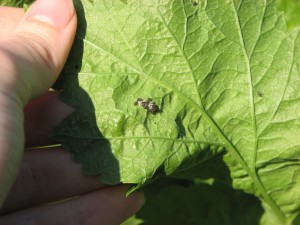
Insect Egg Cluster on Parsnips My daughter’s eagle eyes spotted a cluster of insect eggs on the underside of our parsnip leaves. Many moths and butterflies are laying their eggs right now, so seeing a little white pearl glued to the underside of a leaf isn’t strange.

Unknown Butterfly Egg The parsnips in question are late in the garden; they’ve been in the ground for a while and don’t like the heat so they are stressed. Just as we become sick when stressed, so do plants, and the parsnips are under attack by aphids and ants. Ants feed off of the sticky excretions of the aphids, so they have become ranchers. Ants cultivate herds of aphids on stressed plants, grooming them and collecting their, um, poo. So trying to put that image out of your head, if you see a lot of ants on a plant, expect aphids to be there also. Aphids have rasping, sucking mouthparts that they use to eat away at a plant and suck the vital juices out of it. Sorry, there is another image that you probably don’t want. How to get rid of aphids? The natural way would be to make sure your plants aren’t stressed, and allow ladybugs to flourish in your garden.
So what would you do if you saw THIS in your garden?

Ladybug Larvae Eating Aphids Run screaming? Hit it with a trowel? Wait! You shouldn’t do any of those things! These are baby ladybugs! Just as many children do not resemble the adult into which they will grow, ladybug larvae look like something that Godzilla might take on… if the larvae were the size of a house or something, which they aren’t. Okay, I’m digressing here.
Back to that cluster of eggs my daughter saw. They were hatching ladybug larvae!

Hatching Ladybug Egg Cluster I’ve never seen them that small before. Good news for the garden: rescue forces are being hatched!

Ladybug Larvae Hatching Ladybug larvae eat more aphids than the adults do (just think of teenagers and refrigerators). When they’ve grown as much as they can, they will transform in to the ladybugs that we all know and love (even though we sing a horrible song to them about leaving the garden to check on a false alarm about fire and their children. And people complain about not being able to keep ladybugs in their yards!)

Ladybug! So if you see a creepy bug on your plants, the sides of your house… anywhere… don’t squish him! It may be part of the Ladybug Larvae Special Forces out to break up the illegal ant ranches in your garden!
-
Goat Milk Crumbly Cheese
A friend of mine and her daughter have several goats and this year they began milking them. Every day. Twice a day. Not without a struggle. As they are lacto-ovo vegetarians as well, they don’t use that much milk. However they have experimented with kefir and cheese. Now they are experimenting with giving some milk away.
I have been a lucky recipient of a quart of freshly milked, unpasteurized goat milk. I intended to make cheese out of it, and in the heating for the cheese the milk would become pasteurized.

Heat Slowly I’ve learned a little about making cheese, and I’d like to learn more. What I made was an easy acid-based spreadable or crumbly cheese. This requires lemon juice or vinegar added when the heated milk reaches 180 degrees F.

Stir in Lemon Juice until Curds Form The milk immediately separates into curds and whey.

Pour Curds and Whey into Cheesecloth This is poured through cheesecloth,

Tie Cheese into Cheesecloth then all four corners tied and the cheese suspended over a pot or bowl to drain.

Hang Cheesecloth Over Pot to Drain My result was like a dry cottage cheese. I hung it longer than recommended, so perhaps too much moisture seeped away. Then, before I combined it with seasonings, I put it into the refrigerator since I was busy with something else. I think that hardened up the cheese as well. The seasonings didn’t so much as combine with the cheese curds as they just mixed up with them.

Mix Crumbly Cheese with Seasonings That worked out okay. Instead of spreading the cheese on toast, I crumbled it into a vegetable and pasta dish for dinner and it was tasty, as well as a good extra source of protein, and just fun to eat because we had made it from the milk of goats we have met!

Serve with Pasta and Vegetables A quart doesn’t make much cheese; in fact, it made about half a cup of crumbly cheese.
The whey is a rich souce of nutrition, but is often thrown away. With the acid added to it, it has an unpleasant flavor for drinking. I used it, with the addition of more water, to boil the pasta for the meal, then after it cooled poured it on my outdoor plants. You can use it to replace water in baking or feed it to your chickens… just don’t dump it down the sink!
This recipe is for a quart of goat milk, which doesn’t produce much cheese. Recipes I looked at all recommended a quarter cup of lemon juice, but the cheese curdled for me at no more than an eighth of a cup. Maybe you’ll have different results. You don’t have to hunt down a goatkeeper, either. Goatmilk is sold in supermarkets.
Crumbly Goat Milk CheeseAuthor: Diane C. KennedyRecipe type: Side DishPrep time:Cook time:Total time:Serves: ¼ cupHave a quart of goat milk? Make a little cheese with it!Ingredients- One quart fresh goat's milk
- Up to ⅛th cup fresh lemon juice or vinegar
- Seasonings such as half a garlic clove grated, thyme, Herbs du Provence, etc., and coarse salt
Instructions- Affix a cooking thermometer to the side of a medium saucepan.
- Add goat milk so that the thermometer is submersed in the liquid but not touching the bottom.
- Heat over medium heat until the temperature reaches 180 F.
- Remove pot from heat and gauge from side of pot.
- Stir in lemon juice or vinegar a teaspoon at a time until curds form. You'll know it when it happens! There will be curd and almost clear whey.
- Line a bowl with double layer cheesecloth.
- Pour contents of pot into cheesecloth.
- Tie corners of cheesecloth together over a wooden spoon and allow to hang over bowl or pot to drain.
- Drain cheese one hour or more. The longer you drain it, the more dry it will be.
- Remove cheese from cheesecloth and place in bowl with the seasonings of your choice. Sprinkle with coarse salt.
- Use crumbly cheese on top of hot pasta or vegetables.
-
Is She a He???
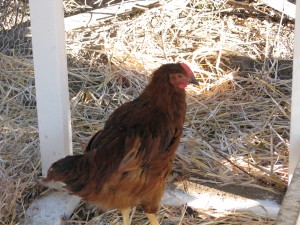
Rooster in Disguise? Problems in Chicken Land! Of the seven hens we’ve raised from chicks, one has played us false! Or so my daughter (the birder) speculated upon her arrival home from college. Our one Rhode Island Red, which is a larger breed so we chose the smallest chick in the batch, is showing signs of not being, shall we say, hennish. First of all, she is large. Really big feet. Ever hear the Fats Waller song, Your Feets Too Big? That applies here. Most notably, though, are her tail feathers, which are starting to take on a more colorful life of their own. They are a little longer and have some bluish-green hues in them that hens, well, just don’t care about. She has become a bully to all the others, especially the largest Americauna, Chickpea.
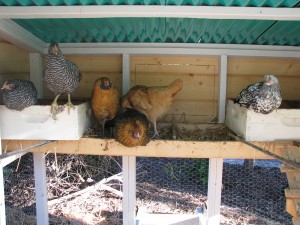
And I thought they were being hen pecked! I had attributed the temper to her being a redhead, but apparently there are other explanations. She is developing admirable wattles, which is something I don’t get to say to just anyone. Also, she has very shiny neck feathers, and roosters have an oil gland they use to preen their feathers. However, she hasn’t yet crowed, but Internet research tells us that some crow early, some late, some not at all. Also, she hasn’t grown spurs yet, but the story is the same as the crowing. One chicken site informed us that it was easy to sex Rhode Island Red chicks because the females have a black stripe on their heads.

It seems like only yesterday.... No stripe on this one, yet if it is so easy to sex them, why was this male in with the females at the store? If indeed she is a male.

Trying to blend in.... So what if she is a he? I don’t know yet. My neighbors would have a fit if I had a crowing rooster in my yard. Rural as it is here, there is a certain peacefulness that rolls across the land and a screaming bird just doesn’t fit in. Also, I’m a lacto-ovo vegetarian. I eat eggs, but not animals, so I don’t want fertile eggs or chicks. Nor do I want my other girls harassed all the time. However, I’ve raised this bird from a day old, and I don’t give over my responsibilities lightly. The hens won’t begin to lay for a couple more months, so I have some time to consider.
I wonder if my vet would fix a chicken?
Here is the whole cast of characters:
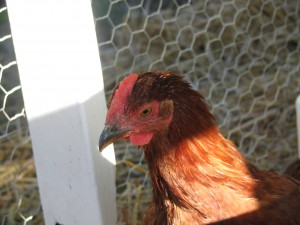
Emerson Emerson: if our speculation is in error, and she is not a he, but she is a she, then she can assume the name Emily.

Blondie/Evelyn Blondie. Not the most original name, but the song Heart of Glass comes to mind whenever I see her. Blondie is Emerson’s chosen consort (another reason Emerson must be a male…. going for the blonds!) UPDATE: Blondie has been renamed Evelyn to move from music to fiction genres. Emerson, Miss Amelia and Eveyln are all characters in Elizabeth Peter’s Amelia Peabody series.

Lark 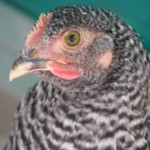
Linnet Lark and Linnet: the youngest chickens by a few weeks, these Barred Rocks pair off and are quite smart. Comparatively. Lark is darker than Linnet.
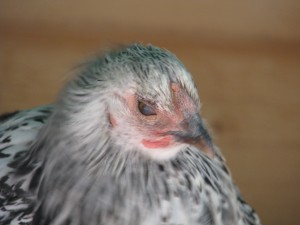
Miss Amelia Miss Amelia: the Silver Wyandotte. Named after the intrepid heroine of Elizabeth Peters’s Amelia Peabody historical archeological mysteries. She likes to sit on the highest perch.

Kakapo (a New Zealand bird... she looks like one!) Kakapo: the lighter colored Americauna. Her posture and neck feathers are much like the New Zealand bird after which she is named.

Chickpea Chickpea: the largest Americauna since the beginning, but the most picked upon. Her coloring is dark where Kakapo’s is light. She manages to hide under the others effectively.
If it’s not one thing, it’s another!


